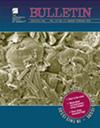欧亚大陆下伊扎那基-太平洋洋脊俯冲的时间:来自日本北海道变质底的约束
IF 3.9
1区 地球科学
Q1 GEOSCIENCES, MULTIDISCIPLINARY
引用次数: 0
摘要
太平洋板块在欧亚大陆下的俯冲作用不仅控制着新生代板内火山活动,而且控制着东亚大陆边缘的深源地震。然而,古太平洋(伊扎那吉)-太平洋脊的俯冲时间和太平洋板块在欧亚大陆下的初始俯冲时间仍然是争论的主题。变质底岩为洋脊俯冲提供了重要证据,并与同期火成岩活动相结合,被广泛用于限定洋脊俯冲的时间。在这里,我们提出了对日本北部北海道日高变质带的角闪岩的研究结果,这些角闪岩被解释为变质鞋底。我们的综合研究包括二次离子质谱(SIMS) U-Pb锆石定年、矿物化学、全岩地球化学和Sr-Nd-Pb-Hf同位素分析。SIMS U-Pb锆石定年表明,角闪岩相底变质作用发生在晚始新世。相平衡模型表明,变质作用的峰值P - T条件为8.0 ~ 9.5 kbar/700 ~ 730℃。角闪岩属拉斑岩系列,相对于轻稀土元素,重稀土元素相对富集,Nb、Ta、P、Ti等元素相对富集。εNd(t) = +11.65 ~ +11.96, εHf(t) = +14.28 ~ +16.32, (206Pb/204Pb)i = 18.240 ~ 18.255, (207Pb/204Pb)i = 15.522 ~ 15.525。这些角闪岩的地球化学特征表明,它们的原岩具有正常的洋中脊玄武岩亲缘关系,其Pb同位素特征显示为印度型地幔而非太平洋型地幔。结合同期岩浆岩的地球化学特征,我们认为Hidaka变质带的晚始新世变质作用记录了由早期地幔楔向俯冲板块顶部的热传递引起的洋内俯冲,并为伊扎那吉-太平洋脊的俯冲时间提供了关键约束条件。本文章由计算机程序翻译,如有差异,请以英文原文为准。
Timing of Izanagi-Pacific ridge subduction beneath Eurasia: Constraints from metamorphic soles in Hokkaido, Japan
The subduction of the Pacific Plate beneath Eurasia controls not only Cenozoic intraplate volcanism, but also deep-focus earthquakes along the continental margin of eastern Asia. However, the timing of subduction of the Paleo-Pacific (Izanagi)−Pacific ridge and the initial subduction of the Pacific Plate beneath Eurasia remain subjects of debate. Metamorphic soles provide key evidence for ridge subduction, and together with coeval igneous activity, they are widely used to constrain the timing of ridge subduction. Here, we present the results of a study of amphibolites from the Hidaka metamorphic belt, Hokkaido, northern Japan, which are interpreted to be metamorphic soles. Our integrated study involved secondary ion mass spectrometry (SIMS) U-Pb zircon dating, mineral chemistry, whole-rock geochemistry, and Sr-Nd-Pb-Hf isotopic analyses. SIMS U-Pb zircon dating indicates that the amphibolite-facies sole metamorphism occurred in the late Eocene. Phase equilibria modeling suggests that the peak P−T conditions of metamorphism were 8.0−9.5 kbar/700−730 °C. The amphibolites belong to the tholeiitic series, and they are relatively enriched in heavy rare earth elements relative to light rare earth elements, with depletions in Nb, Ta, P, and Ti. They have (87Sr/86Sr)i = 0.704207−0.704998, εNd(t) = +11.65 to +11.96, εHf(t) = +14.28 to +16.32, (206Pb/204Pb)i = 18.240−18.255, and (207Pb/204Pb)i = 15.522−15.525. The geochemistry of these amphibolites reveals that their protoliths had normal mid-oceanic-ridge basalt affinities, and their Pb isotopic signatures indicate Indian-type mantle rather than Pacific-type mantle. Considering the geochemistry of coeval igneous rocks, we conclude that the late Eocene metamorphism in the Hidaka metamorphic belt records the intraoceanic subduction that followed heat transfer from the incipient mantle wedge toward the top of the subducting plate, and it provides a key constraint on the timing of subduction of the Izanagi-Pacific ridge.
求助全文
通过发布文献求助,成功后即可免费获取论文全文。
去求助
来源期刊

Geological Society of America Bulletin
地学-地球科学综合
CiteScore
9.30
自引率
8.20%
发文量
159
审稿时长
4-8 weeks
期刊介绍:
The GSA Bulletin is the Society''s premier scholarly journal, published continuously since 1890. Its first editor was William John (WJ) McGee, who was responsible for establishing much of its original style and format. Fully refereed, each bimonthly issue includes 16-20 papers focusing on the most definitive, timely, and classic-style research in all earth-science disciplines. The Bulletin welcomes most contributions that are data-rich, mature studies of broad interest (i.e., of interest to more than one sub-discipline of earth science) and of lasting, archival quality. These include (but are not limited to) studies related to tectonics, structural geology, geochemistry, geophysics, hydrogeology, marine geology, paleoclimatology, planetary geology, quaternary geology/geomorphology, sedimentary geology, stratigraphy, and volcanology. The journal is committed to further developing both the scope of its content and its international profile so that it publishes the most current earth science research that will be of wide interest to geoscientists.
 求助内容:
求助内容: 应助结果提醒方式:
应助结果提醒方式:


